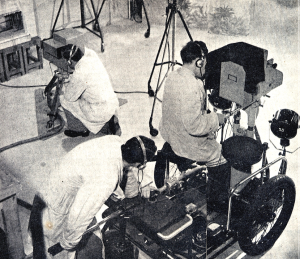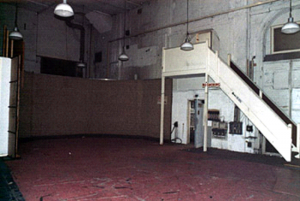John Howell
Here is a scan of a page from a "Popular Science Educator" style of book. Enthusiasts of cameras and dollies etc may be interested.
(Click on the picture below to see larger version:
use your Browser’s BACK button to return to this page)
Maurice Fleisher
AP had studios A and B.
LG had Studios D, E, F, G and H (although F was a scene store).
Anyone know where Studio C was?
John Howell
Lime Grove had Studio R as well, used in later years as a Sound Studio for TV and VT dubbing prior to the arrival of the Sypher Suites.
I think there were also 2 control rooms labeled ‘Studio P’ and ‘Studio Q’ for presentation use.
Studio R used to be manned by Jack Timms, an ex Decca recording engineer who spoke of cutting discs for Django Reinhardt and Stephane Grappelli at the Hot Club de France.
Bernie Newnham
To quote Martin Kempton:
http://www.tvstudiohistory.co.uk/old%20bbc%20studios.htm#alexandra
"…It was clear even in the early days of television that these two small studios were insufficient for a full television service. The old Victorian theatre within the building, which had not been used for years, was acquired by the BBC and detailed technical plans were drawn up as to how it might become Studio C. In the meantime it was used as a rehearsal room and to store scenery. However, history intervened and all plans were put on hold for many years. Studio C was never built at AP – the BBC’s designs for expansion would eventually be made elsewhere…."
Simon Vaughan (Archivist, Alexandra Palace Television Society)
Further to the subject of Studio C at AP.
There were plans pre-war to turn the Victorian Theatre into a huge 12-camera channel studio, with the control room built in the middle so it would have a 360 degree view of the whole studio. These plans were very elaborate and discussions progressed for most of 1937 to 1939, when the plan was scrapped – never to return. Indeed we have one single blueprint from this elaborate plan and the minutes of the equipment committee in the APTS Archive.
Tony Bridgewater, one of the original AP engineers, always maintained that the converted theatre was to be named Studio C. Plans were abandoned only due to expense, the impending war, and the expansion of television to Birmingham. However, it was always planned that AP would have a third studio – a Studio C, (an announcers’ studio), but this never materialised. For this reason "C" was not used at LG when the studios were relabelled from film stages to TV studios.
With regard to the theatre being used as a dubbing theatre – this seems unlikely. The projection box was certainly built above the dress circle, but at some point during 1910-1920, when an attempt was made to turn the struggling theatre into a bioscope – however this didn’t last long.
I have read an account of narrating "War In The Air" (but can’t remember where) and feel sure it mentions that the series was dubbed in the (already established) dubbing theatre at AP, not an additional one installed in the theatre.
I have also read histories where authors have claimed that Studio C was indeed the Baird Spotlight Studio (Studio A = Marconi/EMI, Studio B = Baird), so therefore the other Baird studio was labelled C. Again Tony Bridgewater dispelled this theory – the Baird occupation of the studios only lasted until 4 months from the time the service started!
Ian Hillson
When I was at AP in the late nineteen sixties, there was no mention of Studio C but they had created a small gallery C on the same level as B gallery but accessed by the stairs in News CAR and, I think, by those stairs on the south wall of Studio B (see Nigel Finnis picture below ). It was situated one level above the bricked up colonnade next to Studio B which was News CAR in the 1960s and became the apparatus room for Studio B in the OU era.
(Click on the picture below to see larger version:
use your Browser’s BACK button to return to this page)
Alan Stokes
I see in the drawing on the http://www.tvstudiohistory.co.uk/old%20bbc%20studios.htm#alexandra web page that the Marconi-EMI and Baird systems had separate transmitters. So, even from day 1, to enjoy the full BBC Television Service you needed a dual-standard receiver. What channel/frequency did Baird use then? Marconi-EMI was on Band 1, Channel 1 and I always assumed that Baird used the same. It seems that they shared the sound TX.
Dave Plowman
I can remember as a lad we had a pre WW2 radiogram, and on the tuning scale was marked ‘TV sound’ in a short wave band.
Ian Hillson, Dave Plowman, John Howell
From: BBC press release (for publication on or after Monday, August 24, 1936)
"… the equipment comprises a television studio for each system, with an associated control room and ultra short wave television transmitter; and, in addition, an ultra short wave sound transmitter common to both systems…"
http://www.transdiffusion.org/2003/07/09/ally_pally
The pre-war transmissions didn’t use any of the later VHF frequencies: in this context, ‘ultra short wave’ refers to wavelengths below 10 Metres.
From: Newnes Television & Short-Wave Handbook published 1934:
"… There are many amateur transmitters working on the 5 metre wavelength, and, of course, there are the independent experiments carried out by the Baird Company from the Crystal Palace on a wavelength of 6.25 Metres…"
At this time, wavelengths as short as 3 metres (ie VHF 100MHz) would be impossible to handle in domestic receivers, stray capacities and stability being difficult to deal with, to say nothing of the availability of valves with low inter-electrode capacities and sufficient gain.
"… TV sets were dual-standard: 240-line/25-frame for Baird and 405/50 for Marconi-EMI…"
See: http://www.transdiffusion.org/2003/03/13/fools_2
(Click on the picture below to see larger version:
use your Browser’s BACK button to return to this page)
Dave Buckley
I worked at AP from September 1963 until early 1967 when I moved to LG.
One Sunday afternoon, three of us had a conducted tour of the unused parts of the BBCs section of AP which included the Victorian theatre and under the stage where the traps were still in place and in working condition.
Although the theatre wasn’t used for TV, one of my colleagues commented that it had been a dubbing theatre at one time and that the series “War in the Air” was dubbed there. There was certainly what looked like a projection box built at one end of the theatre. However, I cannot confirm this and the Arthur Dungate website available via the VT oldboys site, doesn’t even mention the Victorian theatre nor “War in the Air”.






